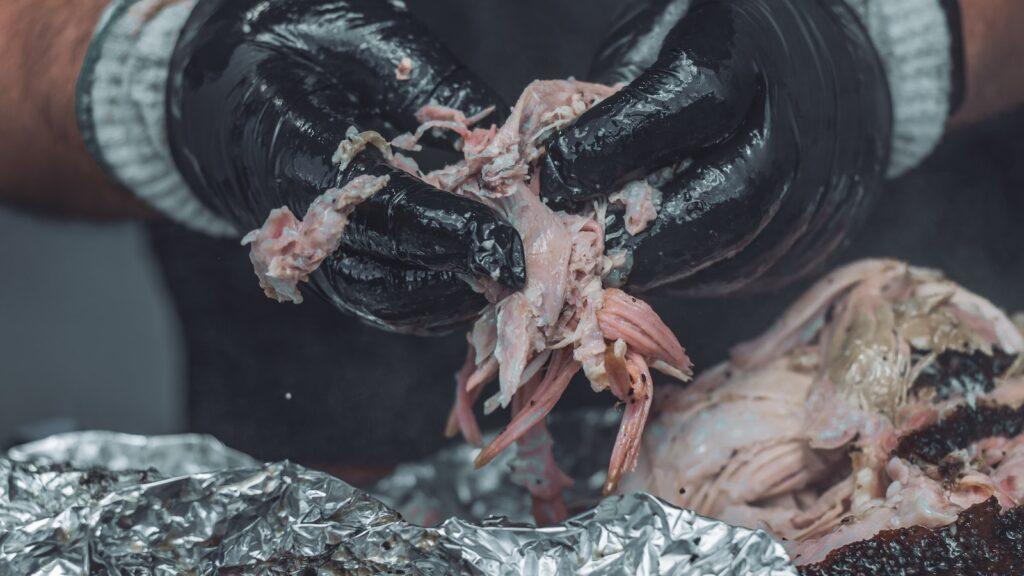There’s something truly magical about the art of smoking meat on a pellet grill, and when it comes to barbecue, nothing quite captures the essence of Texas like a slow-smoked brisket. The smoky aroma, the melt-in-your-mouth tenderness, and the rich flavor that comes from hours of patient cooking make Texas-style smoked brisket a legendary dish that every barbecue enthusiast dreams of mastering.
Smoked Pellet Grill Brisket Recipe
Course: Main Course Cuisine: American Prep Time: 30 minutes Cook Time: 19 hours Resting Time: 1 hour Total Time: 20 hours 30 minutes Servings: 16 people Calories: 280 kcal
Ingredients:
- 1 (12-16) pound whole packer brisket
- ¼ cup salt
- ¼ cup black pepper
Instructions:
- Trimming the Brisket:
- Remove the brisket from the refrigerator and start trimming.
- Trim the fat cap to about ¼-inch thick and trim any gray edges.
- Flip the brisket over and trim any excessive fat patches and silver skin.
- Locate the hard fat mass near the point cut and remove it, leaving the meat underneath the fat intact.
- Seasoning the Brisket:
- Mix together the salt and black pepper.
- Sprinkle the salt and pepper mixture all over the surface of the meat and fat cap, including the sides.
- Let the seasoned brisket sit at room temperature for an hour.
- Smoking the Brisket:
- Prepare the smoker and set it to 225 degrees Fahrenheit.
- Add a water pan in the smoker and place the brisket fat-side up directly on the grates.
- Insert a leave-in thermometer in the thickest part of the flat cut.
- Close the smoker and smoke until the internal temperature reaches about 160 degrees Fahrenheit.
- The Stall and Texas Crutch:
- When the internal temperature stalls (around 160 degrees Fahrenheit), wrap the brisket in peach butcher paper (Texas crutch) to help it get out of the stall and remain moist.
- Place the wrapped brisket back on the smoker and cook until the internal temperature reaches 200-205 degrees Fahrenheit.
- Resting the Brisket:
- Remove the brisket from the smoker and create a small vent in the butcher paper.
- Let the brisket rest in room temperature for at least an hour, or up to two hours.
- Optionally, you can wrap the brisket in a towel and place it in a dry cooler for up to six hours.
- Slicing and Serving:
- Slice the brisket across the grain, keeping in mind that different cuts will have grains running in different directions.
- Serve the smoked brisket as desired. It’s great on its own or with side dishes like smoked baked beans.
Notes:
- You can use oak or mesquite wood pellets for a true Texas-style flavor.
- The exact stall temperature can vary; if you notice the temperature stalling or fluctuating around 155 degrees Fahrenheit, you can wrap the brisket earlier.
- Make sure to use food-grade butcher paper for wrapping.
- Keep an eye on your pellet hopper to ensure you don’t run out of wood pellets.

Why You’ll Love This Texas-Style Smoked Pellet Grill Brisket Recipe
When you serve up a perfectly smoked brisket, you’re not just offering a meal; you’re delivering an experience. The smoky aroma wafting from the grill, the anticipation as the meat slowly cooks to perfection, and the ultimate reward of that first bite—it’s a culinary journey that leaves a lasting impression on all your senses.
The Simple Elegance of Ingredients
Contrary to the complex rubs and seasonings found in many recipes, a Texas-style smoked brisket stands out for its simplicity. With just three key ingredients—whole packer brisket, salt, and black pepper—you’re allowing the meat to take center stage. This dish honors the beef itself, showcasing its natural flavors and textures without distractions.
Mastering the Art of Trimming
Trimming a brisket can seem intimidating, but with a little guidance, you’ll find it’s a manageable process. Begin by carefully removing excess fat, allowing the meat’s marbling to shine through. We recommend aiming for a ¼-inch thick fat cap, which will render beautifully during smoking. The trimming process also involves removing certain tough sections, like the hard fat mass near the point cut.
The Low and Slow Smoking Technique
The essence of Texas-style brisket lies in its low and slow cooking method. As you place the brisket onto the pellet grill at a steady 225 degrees, the meat’s internal temperature gradually rises. When it reaches around 160 degrees, you’ll encounter the “stall.” This is a moment where the meat’s temperature seems to plateau, causing many to worry that something’s amiss. Fear not! This stall is a natural part of the cooking process, as the meat’s connective tissues begin to break down. At this point, wrapping the brisket in peach butcher paper, a technique known as the Texas crutch, helps push past the stall while preserving moisture.
The Grand Finale: Resting and Slicing
After hours of patient anticipation, it’s time to bring your masterpiece to the table. But wait—there’s one more critical step. Allowing the brisket to rest for at least an hour (and ideally up to two hours) is crucial for redistributing its juices and maximizing tenderness. When you finally slice across the grain, the result is a symphony of textures and flavors that speak to the heart of authentic Texas barbecue.
Expert Tips to Elevate Your Smoked Brisket Experience
Trimming with Precision
While the initial trimming may seem daunting, remember that perfection isn’t the goal. Aim to remove excess fat and tough sections, but don’t worry about absolute perfection. Some fat is necessary to keep the meat moist and flavorful.
Investing in Quality
The quality of your brisket matters. Whenever possible, opt for prime briskets from local butcher shops. The superior marbling and flavor of prime cuts elevate the final result.
Patience During the Stall
The stall can test your patience, but remember that it’s a sign of progress. Embrace this moment and trust the process—it’s all part of achieving that tender, smoky perfection.
Respect the Rest
Resist the temptation to cut into the brisket immediately after cooking. Allowing the meat to rest redistributes its juices, ensuring a succulent and flavorful outcome.
Pairing and Serving Texas-Style Smoked Brisket
The beauty of a Texas-style brisket is its ability to stand on its own. Purists often enjoy it without accompaniments, savoring the rich flavors of the meat. However, if you’re looking to complement your brisket, consider serving it with sandwich bread, onion slices, and pickle chips on the side. While sauce isn’t a traditional pairing with Texas brisket, feel free to experiment with your favorites.
Perfect Pairings
To elevate your barbecue experience, consider pairing your smoked brisket with beverages that complement its bold flavors. A robust stout boasts roasted malt notes that harmonize beautifully with the smokiness of the meat. Alternatively, a syrah wine offers a contrast of berry notes and spice that enhances the overall dining experience. And if you’re a cocktail enthusiast, a bourbon-based drink like a sweet tea mint julep strikes the perfect balance between refreshing and robust.
The Journey to Texas-Style Barbecue Mastery
Mastering the art of Texas-style smoked brisket is a journey that combines technique, patience, and a deep appreciation for the craft. By focusing on quality ingredients, meticulous trimming, and the low and slow cooking process, you’re well on your way to achieving the pinnacle of barbecue excellence. So fire up your pellet grill, embrace the smoky adventure, and savor the rewards of your dedication—a perfectly smoked Texas-style brisket that will undoubtedly leave an indelible mark on your culinary repertoire.
FAQ – Smoked Pellet Grill Brisket Recipe
How do I trim a brisket?
To trim a brisket, follow these steps:
- Start by removing excess fat from the brisket when it’s cold for easier trimming.
- Locate the hard fat mass near the point cut and remove it, leaving the meat underneath intact.
- Sprinkle a mixture of salt and black pepper all over the surface of the meat and fat cap.
- Let the seasoned brisket sit at room temperature for an hour before cooking.
What’s the best wood for smoking brisket?
For an authentic Texas brisket flavor, use oak or mesquite wood pellets. Mesquite is a popular choice as it imparts a bold and smoky flavor that complements the large cut of meat.
How long should I rest the brisket?
After cooking, let the brisket rest for at least an hour, but ideally for two hours. You can create small vents in the butcher paper and let the brisket sit at room temperature. For longer resting periods, wrap the brisket in a towel and place it in a dry cooler without ice, where it can maintain its temperature for up to six hours. Resting is crucial for the juices to settle and ensure a moist, tender brisket.
Can I finish cooking brisket in the oven?
Yes, you can finish cooking brisket in the oven at 225 degrees Fahrenheit. Simply place the brisket on a large baking sheet and continue cooking. This can be useful if you encounter bad weather or equipment issues while smoking the brisket. The smoky flavor will already be infused from the initial smoking process.
What are some expert tips for smoking brisket?
Here are some expert tips:
- Trim excess fat when the brisket is cold for easier trimming.
- Monitor your pellet hopper to avoid running out of wood pellets during the long smoking process.
- Use oak or mesquite wood for bold flavor.
- Let the brisket rest for optimal juiciness and tenderness.
What’s the perfect pairing for smoked brisket?
For a beverage pairing, consider a bold stout with roasted malt flavors, which complement the smokiness of the brisket. Alternatively, a syrah wine can provide berry notes, spice, and a touch of smokiness that beautifully match the cooking style.
Last updated: October 23, 2023

